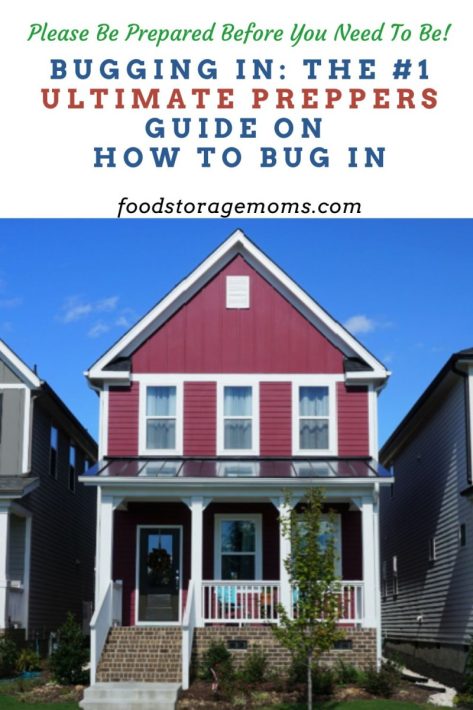By Linda Loosli


What is Bugging In?
“Bugging in” is the term for staying in your home during a disaster or emergency, rather than evacuating to a shelter or another location. For many people, bugging in is the best option, since it allows them to stay in familiar surroundings and avoid the stress of evacuating.
However, bugging in can also be dangerous, since you may be cut off from essential services like food and water. As a result, it’s important to plan carefully if you decide to bug in during an emergency. Make sure you have plenty of supplies on hand and know how to purify water and cook food without electricity.
In addition, it’s a good idea to have a backup plan in case bugging in becomes untenable. But with proper planning, bugging in can be a safe and effective way to weather any storm.
Reasons to Bug In First
There are a number of reasons why bugging in should be your first choice during an emergency.
For one thing, bugging in allows you to stay in familiar surroundings. This can be important both for your physical and mental health. When you’re bugging in, you don’t have to worry about finding shelter or orienting yourself in a new place.
In addition, bugging in can be less stressful than bugging out. When you’re bugging out, you may have to face dangerous conditions like bad weather or civil unrest. Bugging in, on the other hand, allows you to remain in the safety of your own home.
Finally, bugging in can be less expensive than bugging out. If you have to evacuate, you may have to pay for hotels or other accommodations. Bugging in, on the other hand, allows you to stay in your own home for free.
How to Bug In
If you’ve decided that bugging in is the right choice for you, there are a few things you’ll need to do to prepare.
Choose a Bug In Location in Your Home
The first step is to choose a bug in a location in your home. Keeping your entire house running in an emergency is inefficient, and it reduces your security.
Ideally, you should choose a location that is:
- Easy to fortify: Look for a location that can be easily barricaded, such as a basement or an interior room.
- Well-stocked: Make sure your bug in location has enough supplies to last for at least a week.
- Comfortable: Choose a location that is comfortable to stay in for extended periods of time.
Make Sure You Have Access to Water
The best way to ensure you have access to water is to stockpile it. A good rule of thumb is to have at least 1 gallon of water per person per day. For example, 200 gallons of water can last a family of 5 for approximately 40 days. Read my guide on How to Store Water For Drinking and Cooking for more information on how to stockpile water.
Stock Up on Emergency Food
Your bugging-in location should also be stocked with enough food to last for at least a month.
Canned goods are a good option since they have a long shelf life and don’t require cooking. However, make sure you have a can opener on hand, as well as some non-perishable food items such as granola bars or peanut butter.
In addition, it’s a good idea to have freeze-dried meals such as the ReadyWise Emergency Food Supply Make sure to have a bucket for each person in your household. I opted not to purchase meals because I enjoy cooking myself. But I get it, sometimes having a few buckets of food may work for some people.
Make Sure To Have Heat and Light
If you are bugging in during the winter, make sure you have a way to keep your bugging-in location warm. A wood-burning stove (outdoors one) is a good option, but you’ll need to make sure you have enough wood to last for at least a month.
In addition, it’s a good idea to have flashlights and candles on hand in case of a power outage. Make sure to have plenty of batteries on hand as well.
Finally, it’s a good idea to have a battery-operated radio so you can stay up-to-date on the latest news and weather reports.
Insulate Your Bug In Location
Once you have a heat source and lights, the next step in keeping your shelter warm will be to insulate it.
One way to insulate your bugging-in location is to use Reflectix. This material is designed to reflect heat, and it can be taped or stapled to walls and ceilings.
Use blankets and/or towels to seal the cracks underneath your doors and drape them over windows. Finally, make sure that everyone in your home has heavy blankets or a warm sleeping bag at night.
Have a Way to Deal with Human Waste
If you’re bugging in for an extended period of time, you’ll need to find a way to deal with human waste.
- Composting toilet: One option is to use a composting toilet. These toilets don’t require water or electricity, and they can turn human waste into compost that can be used to fertilize plants.
- Bucket toilet: Another option is to use a bucket toilet. This involves using a bucket as a toilet and then dumping the waste in a designated area away from your bugging-in location.
- Latrine: Finally, you can also build an outdoor latrine. This is essentially a hole in the ground that is covered with a sheet of plywood.
Secure Your Location
If there is a prolonged disaster, you will inevitably be subject to looters. As such, it’s important to secure your bugging-in location as much as possible.
- Fortification: One way to do this is to build a fortification. This can be something as simple as boarding up your windows and doors with plywood.
- Security equipment: Another option is to install security cameras and/or motion sensor lights around your property. This will deter looters, as they will not want to be caught on camera.
- Alarm: Finally, you should also have a security system in places such as an alarm system or a barking dog.
Read my post: How to Prepare Your House Against Looters for more information.
Add Fitness Activities and Games to Your Location
If you’re bugging in with family, it’s important to keep everyone entertained. This will help to prevent boredom and cabin fever.
One way to do this is to add fitness activities to your bugging-in location. This can be something as simple as setting up a makeshift gym in your garage or backyard.
Another option is to bring out board games or puzzles. This will help to pass the time and keep everyone’s mind active.
Finally, you can also use this time to teach your children (or yourself) new skills such as gardening or hunting.
When Should I Bug Out?
There are certain situations where bugging in is not the best option.
If your bugging-in location is in an area that is prone to flooding or wildfires, bugging out may be a better option.
In addition, if your bugging-in location is in an urban area, bugging out may also be a better option. This is because urban areas are more likely to experience crime and riots during a disaster.
Finally, if you don’t feel safe bugging in, bugging out may also be the best option. No matter what, it’s important to have a plan in place so you can bug in or bug out depending on the situation.
Final Word
Bugging in is a great option for those who want to be prepared for a disaster. By following the tips above, you can make sure that your bugging-in location is as safe and comfortable as possible.
Do you have any other tips for bugging in? Let me know in the comments below! May God Bless this world, Linda
Copyright Images: Two Story Row House AdobeStock_241421344 by PT Hamilton
No comments:
Post a Comment